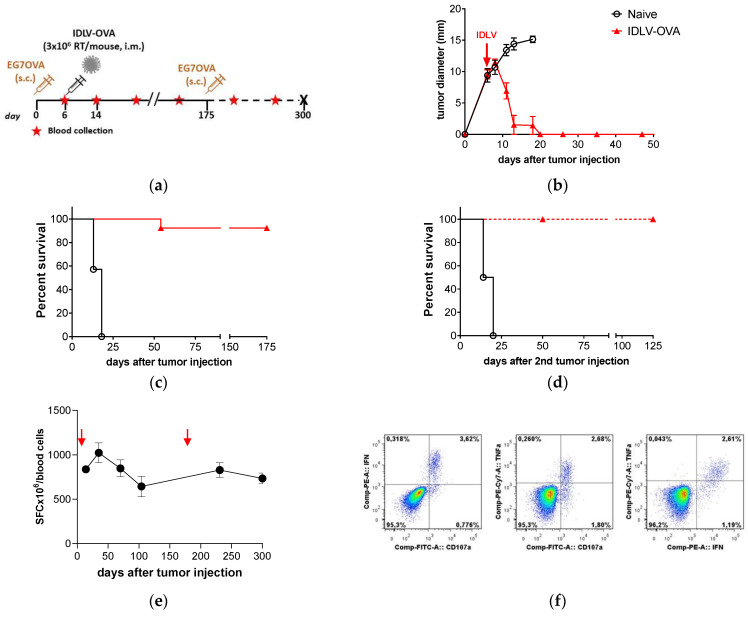Figure 1.
Therapeutic efficacy of integrase-defective lentiviral vectors (IDLV)-ovalbumin (OVA) vaccination in E.G7-OVA-bearing mice. (a) Scheme of the experiment: 14 C57BL/6 mice were inoculated s.c. with 3.5 × 106 E.G7-OVA cells/mouse. Mice with 7–9 mm diameter tumor mass were vaccinated with 3 × 106 RT/mouse of IDLV-OVA (n = 7) or left untreated (Naïve, n = 7). Tumor growth, survival, and immune response were monitored over time. Tumor-free mice were injected a second time with tumor cells at 175 days and monitored up to the end of the experiment (300 days). (b) Tumor growth after the first tumor injection is shown. Mice were sacrificed when the tumor diameter reached 15 mm or an ulceration of tumor was observed. (c,d) Kaplan–Meier survival curves are shown. Survival was monitored up to 175 days after the first tumor injection (Log-rank Mantel-Cox test) and up to 125 days from the second tumor injection (Log-rank Mantel-Cox test). (e) Kinetics of OVA-specific T cell response in IDLV-OVA vaccinated mice, after E.G7-OVA injection (red arrows). Blood cells were collected at the indicated time points and stimulated with the H-2Kb restricted OVA 8mer peptide (SIINFEKL). Data are expressed as specific spot forming cells (SFC) per 106 cells. Error bars indicate the standard deviation among the animals from the same group. (f) Polyfunctional OVA-specific CD8+ T cells. Vaccinated and tumor-free mice were sacrificed at 300 days and splenocytes were used to evaluate the magnitude and quality of OVA-specific CD8+ T cell response by intracellular cytokine staining (ICS). A representative experiment is shown. CD8+ T cells were analyzed in splenocytes stimulated with OVA 8mer peptide (OVApep). The percentage of CD8+ T cells producing IFNγ and TNFα and expressing CD107a is indicated within the quadrants.

